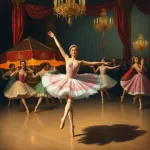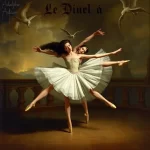Ballet: Le Carnaval (Robert Schumann, 1910)

Introduction
Ballet: Le Carnaval is a captivating one-act ballet set to the music of Robert Schumann, choreographed by Mikhail Fokine. Premiering in 1910, this ballet is a vibrant and whimsical portrayal of a masked ball, filled with romantic entanglements and comedic misunderstandings. The ballet’s plot revolves around a series of character interactions at a carnival, drawing inspiration from the commedia dell’arte tradition.
Historical Background
Creation and Development
The early 20th century was a period of significant transformation in the arts, marked by a shift towards modernism and experimentation. Le Carnaval was created during this dynamic era, influenced by the burgeoning interest in blending different art forms. The ballet was inspired by Schumann’s piano suite Carnaval, Op. 9, which itself was influenced by the commedia dell’arte, a form of Italian theater characterized by masked characters and improvised performances.
Mikhail Fokine, a pioneering choreographer, collaborated closely with composer Robert Schumann to bring this ballet to life. Fokine’s innovative approach to choreography, which emphasized expressive movement and dramatic storytelling, was a perfect match for Schumann’s evocative music. The collaboration also involved set and costume designers who contributed to the ballet’s visual appeal.
Premiere and Reception
Le Carnaval premiered on February 20, 1910, at the Mariinsky Theatre in St. Petersburg, Russia. The initial reception was overwhelmingly positive, with critics and audiences praising the ballet’s imaginative choreography, engaging music, and vibrant costumes. The ballet quickly became a staple in the repertoires of major ballet companies, with notable early performances in Paris and London.
Synopsis of the Ballet
Le Carnaval is a one-act ballet that unfolds in a series of vignettes, each depicting different characters and their interactions at a carnival. The ballet is known for its lively and humorous portrayal of romantic entanglements and misunderstandings.
Key Moments
- Introduction: The ballet opens with a lively carnival scene, introducing the audience to the colorful and whimsical world of the masked ball.
- Harlequin and Columbine: Harlequin, a mischievous character, attempts to win the affection of Columbine, who is initially indifferent to his advances.
- Pantalone and Pierrot: Pantalone, an old man, tries to court Columbine, but his efforts are thwarted by Pierrot, a sad clown who is also in love with her.
- Finale: The ballet concludes with a joyous and chaotic dance, as all the characters come together in a celebratory finale.
Musical Composition
Composer’s Role
Robert Schumann, a renowned Romantic composer, played a crucial role in the creation of Le Carnaval. His piano suite Carnaval, Op. 9, composed in 1834-1835, served as the musical foundation for the ballet. Schumann’s music is characterized by its lyrical melodies, rich harmonies, and vivid character pieces, which perfectly complement the ballet’s whimsical and dramatic narrative.
Musical Themes and Motifs
The music of Le Carnaval features several recurring themes and motifs that enhance the narrative and emotional depth of the ballet. Each character is associated with a specific musical theme, which helps to convey their personality and emotions. For example, Harlequin’s theme is playful and energetic, while Pierrot’s theme is melancholic and introspective.
Famous Recordings and Performances
Over the years, there have been numerous recordings and performances of Schumann’s Carnaval, both as a piano suite and as part of the ballet. Notable recordings include those by pianists such as Vladimir Horowitz and Martha Argerich, who have brought Schumann’s music to life with their virtuosic interpretations.
Choreography and Dance
Choreographer’s Vision
Mikhail Fokine’s vision for Le Carnaval was to create a ballet that combined expressive movement with dramatic storytelling. Fokine’s choreography is characterized by its fluidity, grace, and attention to detail, which bring the characters and their interactions to life. He also introduced several innovations, such as the use of mime and gesture to convey emotions and narrative elements.
Signature Dance Numbers
- Harlequin’s Dance: A lively and acrobatic solo that showcases Harlequin’s playful and mischievous nature.
- Columbine’s Dance: A graceful and elegant solo that highlights Columbine’s beauty and charm.
- Pierrot’s Dance: A melancholic and expressive solo that reflects Pierrot’s unrequited love for Columbine.
- Finale: A joyous and energetic group dance that brings all the characters together in a celebratory conclusion.
Notable Interpretations
Over the years, different productions of Le Carnaval have interpreted Fokine’s choreography in various ways. Some have stayed true to the original choreography, while others have introduced new elements and innovations. Notable interpretations include those by the Ballets Russes, the Royal Ballet, and the American Ballet Theatre, each of which has brought its unique style and vision to the ballet.
Characters and Roles
Main Characters
- Harlequin: A mischievous and playful character who is in love with Columbine.
- Columbine: A beautiful and charming young woman who is the object of Harlequin’s and Pierrot’s affections.
- Pierrot: A sad and melancholic clown who is also in love with Columbine.
- Pantalone: An old man who tries to court Columbine but is thwarted by Pierrot.
Supporting Characters
- Other Masked Revelers: Various characters who add to the lively and chaotic atmosphere of the carnival.
Famous Dancers
Several notable dancers have portrayed the roles in Le Carnaval over the years. These include Vaslav Nijinsky as Harlequin, Tamara Karsavina as Columbine, and Leonide Massine as Pierrot. Their performances have left a lasting impact on the ballet and have set a high standard for future interpretations.
Cultural and Artistic Impact
Influence on Ballet and Dance
Le Carnaval has had a significant influence on the world of ballet and dance. Fokine’s innovative choreography and Schumann’s evocative music have inspired countless choreographers and composers. The ballet’s emphasis on expressive movement and dramatic storytelling has also contributed to the development of modern ballet as an art form.
Cultural Significance
Le Carnaval holds a special place in popular culture and has been referenced in various forms of media, including literature, film, and theater. Its whimsical and romantic themes continue to resonate with audiences, making it a timeless classic.
Legacy and Revivals
The legacy of Le Carnaval is evident in the numerous revivals and reinterpretations of the ballet over the years. Major ballet companies around the world continue to perform and celebrate this iconic work, ensuring that it remains a beloved part of the ballet repertoire.
Iconic Productions
Historic Productions
Some of the most famous historical productions of Le Carnaval include those by the Ballets Russes, which premiered the ballet in Paris in 1910. The production featured legendary dancers such as Vaslav Nijinsky and Tamara Karsavina, and was directed by Sergei Diaghilev, a key figure in the world of ballet.
Contemporary Productions
Recent productions of Le Carnaval have brought new interpretations and innovations to the ballet. Companies such as the Royal Ballet and the American Ballet Theatre have staged contemporary versions that incorporate modern elements while staying true to the original spirit of the ballet.
Production Design
The set, costume, and lighting design of Le Carnaval play a crucial role in bringing the whimsical and vibrant world of the carnival to life. Historical productions often featured elaborate and colorful costumes, while contemporary productions have experimented with minimalist and abstract designs.
Critical Reception and Reviews
Initial Critical Response
At the time of its premiere, Le Carnaval received widespread acclaim from critics and audiences alike. The ballet was praised for its innovative choreography, engaging music, and vibrant costumes. Critics noted the seamless integration of Schumann’s music with Fokine’s choreography, creating a cohesive and captivating performance.
Modern Reviews
Contemporary critics continue to appreciate Le Carnaval for its timeless appeal and artistic significance. The ballet is often lauded for its expressive movement, dramatic storytelling, and evocative music. Modern audiences also enjoy the whimsical and romantic themes, making it a popular choice for ballet companies around the world.
Fun Facts and Trivia
Behind-the-Scenes Stories
One interesting anecdote from the production of Le Carnaval involves Vaslav Nijinsky, who played Harlequin in the original Ballets Russes production. Nijinsky was known for his incredible athleticism and grace, and his performance in Le Carnaval was no exception. During one rehearsal, he reportedly performed a series of jumps so high and precise that they left the other dancers in awe.
Notable Performers
In addition to Nijinsky, other famous dancers associated with Le Carnaval include Tamara Karsavina, who played Columbine, and Leonide Massine, who portrayed Pierrot. Their performances have become legendary and have set a high standard for future interpretations of the ballet.
Trivia
- Schumann’s Inspiration: Schumann’s piano suite Carnaval, Op. 9 was inspired by the commedia dell’arte, a form of Italian theater characterized by masked characters and improvised performances.
- Fokine’s Innovations: Mikhail Fokine introduced several innovations in the choreography of Le Carnaval, including the use of mime and gesture to convey emotions and narrative elements.
- Iconic Costumes: The costumes for the original Ballets Russes production of Le Carnaval were designed by Léon Bakst, a renowned artist and set designer known for his vibrant and elaborate designs.
Conclusion
Summary of the Ballet’s Importance
Le Carnaval is a significant work in the world of ballet, known for its innovative choreography, evocative music, and whimsical themes. The collaboration between Mikhail Fokine and Robert Schumann resulted in a timeless classic that continues to captivate audiences and inspire artists.
Final Thoughts
Reflecting on the enduring appeal of Le Carnaval, it is clear that the ballet’s combination of expressive movement, dramatic storytelling, and vibrant music has left a lasting impact on the art form. Whether you are a seasoned ballet enthusiast or a newcomer to the world of dance, Le Carnaval offers a delightful and enchanting experience that is not to be missed.
FAQ
What is the central theme of this ballet?
The central theme of Le Carnaval is the whimsical and romantic interactions between characters at a masked ball, drawing inspiration from the commedia dell’arte tradition.
Who are the main characters in this ballet?
The main characters in Le Carnaval include Harlequin, Columbine, Pierrot, and Pantalone.
What is the most famous dance number in this ballet?
One of the most famous dance numbers in Le Carnaval is Harlequin’s Dance, known for its lively and acrobatic choreography.
How long does a typical performance of this ballet last?
A typical performance of Le Carnaval lasts approximately 30-40 minutes, as it is a one-act ballet.
Are there any modern adaptations of this ballet?
Yes, there have been several modern adaptations of Le Carnaval, with contemporary productions incorporating new elements and innovations while staying true to the original spirit of the ballet.
Why is this ballet considered important in the history of dance?
Le Carnaval is considered important in the history of dance due to its innovative choreography, evocative music, and its role in the development of modern ballet as an art form. The collaboration between Mikhail Fokine and Robert Schumann has left a lasting impact on the world of ballet.





